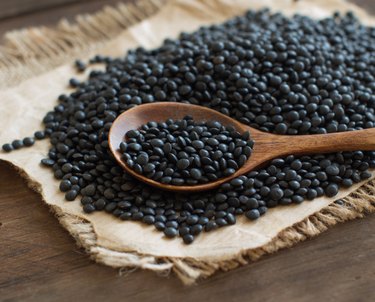
Satisfying and full of nutrients like protein and iron, lentils are a great option whether you're a vegetarian looking for meat-free alternatives or an omnivore wanting to expand your palate. Black lentils, aka beluga lentils, are not as popular as other varieties but are just as versatile.
What Are Lentils?
Video of the Day
The Mayo Clinic explains that lentils fall into the category of legumes, which also encompasses beans and peas. In addition to black or beluga lentils, there are also brown, green and red lentils. Brown is the most common type of lentil, and you will often have to turn to specialty grocery to get red or green ones. Black lentils are a recent addition to the market, but they're similar in firmness to green lentils.
Video of the Day
According to the USDA, 1 cup of cooked lentils has 230 calories, mostly from complex carbohydrates, although they do deliver plenty of protein. That 1-cup serving yields nearly 40 grams of carbohydrates, 15 of which are from dietary fiber, and about 18 grams of protein. The Harvard T.H. Chan School of Public Health points out that they have prebiotics that help with digestion.
Many experts are quick to tout the health benefits of lentils. According to a November 2017 review published in the International Journal of Molecular Sciences, studies have shown that eating lentils can reduce risk of diabetes, obesity, cancer and heart disease, and because they are so inexpensive, they are a cost-effective source of nutrients.
How to Prepare Black Lentils
When you're working with dry beluga lentils, start by sorting them to remove any pieces of debris and rinsing them to remove any dirt. Fortunately, as Mayo Clinic explains, lentils don't need to be presoaked the way other legumes do. You can just put them in a pot, cover them with about a half-inch of water and bring it to a boil.
Once the water is boiling, reduce the heat and simmer uncovered for about 40 minutes. You should check the lentils frequently and add more water if necessary.
The Harvard T.H. Chan School of Public Health lists a recipe for French-style lentils that can be made with black lentils as easily as brown or green. The recipe calls for these dark lentils to be simmered along with carrot, garlic and bay leaves to give them plenty of flavor.
Additionally, once you have removed the lentils from the heat, Harvard recommends draining them and rinsing them with cold water right away to remove excess starch and stop the lentils from overcooking. This will ensure the beluga lentils retain their firm, toothy texture that will make them great for whatever dish you're adding them to.
Read more: Health Consequences of Too Many Lentils
Adding Beluga Lentils to Meals
Once you have your beluga lentils cooked, you can use them in many ways. Of course, they can be enjoyed plain on their own — but these dark lentils will up the quality of many different dishes.
The most obvious use is to toss them into a salad, such as lentil raisin spinach salad or a lentil and tomato spinach salad. If you're feeling ambitious, why not assemble a roasted veggie Buddha bowl with creamy sage cashew sauce?
Or you can add dark lentils to a bowl of whole grains, like brown rice. A recipe from the National Heart, Lung and Blood Institute recommends sautéing lentils on the stovetop with cooked brown rice, onion, kale and olive oil. The recipe calls for brown lentils, but you can easily substitute with your beluga lentils.
Finally, get creative! Harvard offers suggestions like folding lentils into an omelet, stirring them into pasta sauce, using them in place of chickpeas for hummus or even mashing them up to make a veggie burger or meatless meatballs. You'll be surprised by the way these dark lentils can invigorate your next dish.
- Harvard T.H. Chan School of Public Health: “French Style Lentils”
- Mayo Clinic: “Nutrition and Healthy Eating”
- International Journal of Molecular Sciences: “Polyphenol-Rich Lentils and Their Health Promoting Effects”
- USDA: “Lentils (Cooked)”
- Harvard T.H. Chan School of Public Health: “Lentils”
- National Heart, Lung and Blood Institute: “Lentils with Brown Rice and Kale”